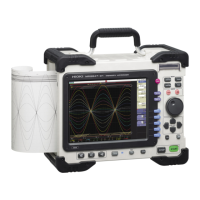11.2 Settings for Waveform Calculation
194
About calculation equations _____________________________________
Operators
See: "11.3 Waveform Calculation Operators and Results" ( p.198)
Entering Calculation Equations
• Each entered calculation equation may contain up to 80 characters.
• Each constant in a calculation equation may contain up to 30 digits.
• For multiplication, use [*]. For division, use [/].
• If a long complicated formula is entered, a question mark (?) is displayed.
Divide the formula into 2 or more parts.
• When dividing by 0, an overflow value is output.
(For positive values, +9.9999E+29. For negative values, -9.9999E+29.)
• The result of calculation Z
i
can be used in other calculation equations. How-
ever, the Z
n
th equation can only refer to the results of equations up to Z
n-1
.
(Example: Equation Z
4
can include the results of equations Z
1
through Z
3
.)
Using the MOV, SLI, DIF and DIF2 operators in an equation
The number # after a comma within parenthesis (_,#) for each operation is set to
the calculation operator.
When calculation results overflow (OVER)
• The value that indicated by the A/B cursor is not a correct value.
• When [Scale] is set to [Auto], waveforms appear at the top or bottom edge of
the screen. This makes calculation result overflow obvious.
Operator Name Operator Name
ABS Absolute Value DIF2 2
nd
Derivative
EXP Exponent INT2 2
nd
Integral
LOG Common Logarithm SIN Sine
SQR Square Root COS Cosine
MOV Moving Average TAN Tangent
SLI Movement parallel to the
time axis
ASIN Inverse Sine
DIF 1
st
Derivative ACOS Inverse Cosine
INT 1
st
Integral ATAN Inverse Tangent
ABS(CH1)+CH2*CH3-(CH4+CH5)*ABS(CH4)/DIF(CH1,1)
12 3
Operator Setting Choice Setting Examples
MOV
(Moving Average)
SLI
(Parallel Movement)
Set the number of points to move.
Setting Range
MOV (Moving Average): 1 to 5000
SLI: -5000 to 5000
Calculate the 10-point mov-
ing average of CH1:
MOV(CH1,10)
DIF
(Derivative)
DIF2
(2nd Derivative)
Specify the sampling interval for dif-
ferentiation.
"1" is normally acceptable, but this
should be set larger to capture fluc-
tuation values of slowly changing
waveforms.
DIF and DIF2 Setting Range: 1 to
5000
Differentiate CH2 using a 20-
point sampling interval:
DIF(CH2,20)

